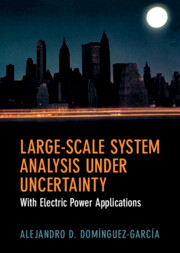Book contents
- Frontmatter
- Dedication
- Contents
- Preface and Acknowledgments
- Notation
- 1 Introduction
- 2 Preliminaries
- 3 Static Systems: Probabilistic Input Uncertainty
- 4 Static Systems: Probabilistic Structural Uncertainty
- 5 Discrete-Time Systems: Probabilistic Input Uncertainty
- 6 Continuous-Time Systems: Probabilistic Input Uncertainty
- 7 Static Systems: Set-Theoretic Input Uncertainty
- 8 Discrete-Time Systems: Set-Theoretic Input Uncertainty
- 9 Continuous-Time Systems: Set-Theoretic Input Uncertainty
- Appendix A Mathematical Background
- Appendix B Power Flow Modeling
- References
- Index
4 - Static Systems: Probabilistic Structural Uncertainty
Published online by Cambridge University Press: 17 January 2022
- Frontmatter
- Dedication
- Contents
- Preface and Acknowledgments
- Notation
- 1 Introduction
- 2 Preliminaries
- 3 Static Systems: Probabilistic Input Uncertainty
- 4 Static Systems: Probabilistic Structural Uncertainty
- 5 Discrete-Time Systems: Probabilistic Input Uncertainty
- 6 Continuous-Time Systems: Probabilistic Input Uncertainty
- 7 Static Systems: Set-Theoretic Input Uncertainty
- 8 Discrete-Time Systems: Set-Theoretic Input Uncertainty
- 9 Continuous-Time Systems: Set-Theoretic Input Uncertainty
- Appendix A Mathematical Background
- Appendix B Power Flow Modeling
- References
- Index
Summary
This chapter studies static systems under structural uncertainty. The first part of the chapter is devoted to the development of a model describing the system stochastic behavior. To this end, we assume that the system can only adopt a finite number of input-to-state mappings, and that transitions among these different mappings are random and governed by a Markov chain. We consider both discrete- and continuous-time settings and provide expressions governing the evolution of the probability distribution associated with the resulting Markov chains. The second part of the chapter tailors the techniques developed earlier to analyze multi-component systems subject to component failures and repairs. Techniques for constructing the system input-to-state model are extensively covered, as this is in general the most difficult part of the analysis when analyzing systems with a large number of components.
Keywords
- Type
- Chapter
- Information
- Large-Scale System Analysis Under UncertaintyWith Electric Power Applications, pp. 91 - 129Publisher: Cambridge University PressPrint publication year: 2022

